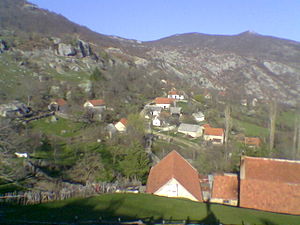
Back Rebelión en el este de Herzegovina de junio de 1941 Spanish Ustanak u Hercegovini 1941. Croatian Rivolta del giugno 1941 nell'Erzegovina orientale Italian Устанак у Херцеговини 1941. Serbian
| June 1941 uprising in eastern Herzegovina | |||||||
|---|---|---|---|---|---|---|---|
| Part of World War II in Yugoslavia | |||||||
 The capture of the gendarmerie post in Gornji Lukavac was one of the first actions of the uprising | |||||||
| |||||||
| Belligerents | |||||||
| Serb rebels from eastern Herzegovina and Montenegro | |||||||
| Commanders and leaders | |||||||
| |||||||
| Units involved | |||||||
| No formed units |
| ||||||
| Strength | |||||||
| 1,500–3,000 |
68 officers, 2,362 men[a] | ||||||
Location of the town of Nevesinje in eastern Herzegovina. The dashed line denotes the boundary between the German (northeastern) and Italian (southwestern) zones. | |||||||
In June 1941, Serbs in eastern Herzegovina rebelled against the authorities of the Independent State of Croatia (Croatian: Nezavisna Država Hrvatska, NDH), an Axis puppet state established during World War II on the territory of the defeated and occupied Kingdom of Yugoslavia. As the NDH imposed its authority, members of the fascist Ustaše ruling party began a genocidal campaign against Serbs throughout the country. In eastern Herzegovina, the Ustaše perpetrated a series of massacres and attacks against the majority Serb population commencing in the first week of June. Between 3 and 22 June 1941, spontaneous clashes occurred between NDH authorities and groups of Serbs in the region.
The German invasion of the Soviet Union began on 22 June. Over the next two days, the sporadic revolts by Serbs against the NDH in eastern Herzegovina erupted into mass rebellion, triggered by Ustaše persecution, Serb solidarity with the Russian people, hatred and fear of the NDH authorities, and other factors. Serb rebels, under the leadership of both local Serbs and Montenegrins, attacked police, gendarmerie, Ustaše and Croatian Home Guard forces in the region. In the first few days, the rebels captured gendarmerie posts in several villages, set up roadblocks on the major roads and ambushed several military vehicles. On the night of 26 June, the rebels mounted a sustained attack on the town of Nevesinje in an attempt to capture it, but the garrison held out until the morning of 28 June when NDH troops broke through the rebel roadblocks.
On 28 June, the rebels ambushed a truckload of Italian soldiers, prompting the Italian Army commander in the NDH to warn the NDH government that he would take unilateral action to secure communication routes. A further gendarmerie post was destroyed by the rebels, and in the evening the rebels captured the village of Avtovac, looting and burning it, and killing dozens of non-Serb civilians. The following day an Italian column cleared the rebels from Avtovac and relieved the hard-pressed NDH garrison in the town of Gacko. From 3 July, an NDH force of over 2,000 fanned out from Nevesinje, clearing towns, villages and routes of rebels. The rebel forces did not put up any significant opposition to the clearing operation, and either retreated into nearby Montenegro, or hid their weapons in the mountains and went home. By 7 July, NDH forces had regained full control of all towns and major transport routes in eastern Herzegovina.
- ^ Marijan 2003, pp. 548–549.
Cite error: There are <ref group=lower-alpha> tags or {{efn}} templates on this page, but the references will not show without a {{reflist|group=lower-alpha}} template or {{notelist}} template (see the help page).
© MMXXIII Rich X Search. We shall prevail. All rights reserved. Rich X Search
